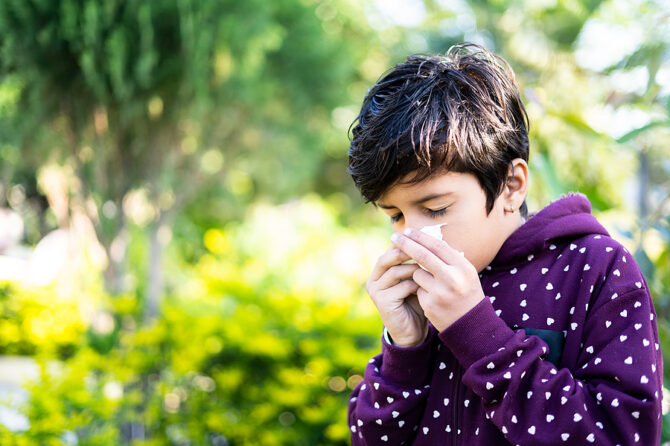
Survival Guide to Seasonal Allergies
by Natalia Darling PA-C [Repost from 2018]
Spring is finally here! For many this is a welcome relief from the cold winter season but for almost 6 million children in the USA suffering from seasonal allergies the advent of spring brings sneezing, itchy and watery eyes, coughs, and itchy and irritated sore throats and post nasal drip. Seasonal or spring/fall allergies, interchangeable with the terms hay fever or allergic rhinitis are all synonyms for a commonly experienced reaction to the weeds, grasses, pollens and trees in our outdoor environment, with symptoms that include but are not limited to;
- Runny nose/nasal congestion
- Sneezing
- Itchy nose, ears, eyes, mouth
- Red watery eyes
- Swelling around eyes
- Post nasal drip
Frequently asked Questions
What does the word rhinitis mean?
Rhinitis is a medical term that means inflammation of the nasal passageways. One of the hallmarks of hay fever/allergic rhinitis is that the nasal passageways become swollen, irritated and inflamed which is often the source of most misery and symptoms when it comes to allergies.
How are allergies diagnosed?
Oftentimes we can diagnose allergic rhinitis by the history you give us and on physical examination. Medical tests (done at an allergists office) can help to confirm the diagnosis and identify the particular allergens but are not typically necessary for most people with seasonal allergies.
How do I reduce my child’s exposure to pollen?
- Avoid exposure to the outdoors when the pollen count is the highest- use websites or apps such as pollen.com or weather.com to get pollen counts for the day.
- Keep your windows closed during the pollen season. When driving, also be sure to close windows and use air conditioning, and make sure that your car is set to circulate air from within rather than pulling it from outside.
- Wash hands and face after entering the house when playing outside. Some people should even go so far as to change out of the clothes they wear outside
- Wear a hat when playing outside, and remove it when your child comes indoors
- Shower and wash hair each night to keep allergens from getting into your bed sheets
- Use allergen protective mattress and pillow covers
- Start taking allergy medicines before pollen season begins, and take them for the whole pollen season versus of on an as needed basis. For spring allergies, we generally recommend starting medicines around late March or early April and continuing them until Memorial Day.
How do I treat seasonal allergies
To fully combat most mild cases of seasonal allergies, allergists generally recommend a combination of the strategies below in addition to the environmental controls, preventative measures, and ways to avoid triggers listed above.
- Intranasal corticosteroids– Intranasal corticosteroids work to counteract and decreased the inflammation in the nose that causes sneezing, congestion, post nasal dip leading to coughing, and itching. Studies have shown that steroid nasal sprays are more effective than oral antihistamines for treatment of seasonal allergies. These nasal sprays have very few side effects, aside from causing bloody noses. To prevent bloody noses, it is important to administer correctly- point the spray of medicine towards the ear, rather than the middle of the nose. Some over-the-counter versions are Flonase Sensimist, Flonase Allergy Relief, and Rhinocort Allergy
- Antihistamines– Oral Antihistamines are medications that help block the effects of allergy cells in the body. They can be short acting such as Benadryl (click here for dosing) or long acting which are dosed once or twice a day. Short acting antihistamines have the drawback of causing more side effects like drowsiness, so we generally recommend the long acting versions such as Zyrtec, Claritin or Allegra for use over extended periods of time.
- Nasal Saline/nasal washes– Rinsing the nose with a salt water wash can be helpful, particularly helpful if you are experiencing post nasal drip, sneezing, dryness and congestion. It works to directly help to rinse allergens and irritants out of the nasal passageways, and can be done once or twice a day if symptoms are severe. It is challenging to get a four year old to do a Nasal wash, so instead you can use nasal saline sprays, although they are not as effective.
- Antihistamine eye drips – Antihistamine eye drops are another tool that is available over the counter for children 2 years and older. They can be used along with the methods above to specifically help with itchy eyes during allergy season. Common OTC brands include Zaditor and Pataday.
- Allergy Immunotherapy – For some children with severe or refractory seasonal allergy symptoms ‘allergy shots’ or allergen immunotherapy can help acclimate the body to specific seasonal allergens. This can, overtime, reduce the severity and frequency of allergy symptoms to this trigger. This is typically offered through an allergist’s office and not something we offer at Potomac Pediatrics. Speak with your provider to see if you may be a candidate and to help with the referral.
Call us at (301) 279- 6750 to receive further advice or to schedule an appointment for evaluation regarding your child’s seasonal allergic rhinitis











Leave a reply